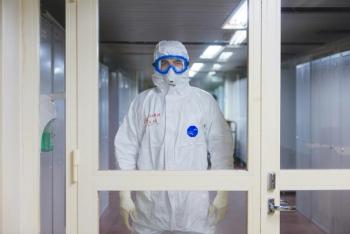
Necrotizing Fasciitis: A Rare Disease with Fatal Consequences
A recent report describing the development of “flesh-eating bacteria” in a Louisiana woman has the public concerned. The infection developed after the woman injured her foot, resulting in bleeding, while surf fishing in the Gulf of Mexico earlier this May.
A recent report out of the New York Daily News on May 31, 2016 describing the development of “flesh-eating bacteria” in a Louisiana woman has the public concerned. The infection developed after the woman injured her foot, resulting in bleeding, while surf fishing in the Gulf of Mexico earlier this May. Subsequent to suffering the injury, the woman developed “flesh-eating bacteria” and underwent two surgeries which left her with a hole in the affected foot.
Although long-known to science and medicine,1,2 the rare disease referred to officially as necrotizing fasciitis (NF) continues to be associated with high mortality rates (range, 6%—76%).1,3-6 The results from the first study to examine the NF mortality rate amongst the Dutch, and the largest study conducted to date in Europe, demonstrate that this remains the case. These findings were published recently in the World Journal of Emergency Surgery.7
NF is a rapidly progressive infection that can affect any part of the body, and usually gains access through a minor injury or a surgical wound. "I started this study because I was very impressed of the severeness of the infection the first time I saw a patient with NF. I was curious about the causes of NF and the prognoses," lead author Sander F. L. van Stigt from the Department of Surgery at the Traumasurgery Radboud University Medical Center in Nijmegen, the Netherlands, told Contagion. To examine NF-related morbidity in the Netherlands, van Stigt and his colleagues retrospectively analyzed all available data from a large cohort of patients who presented with NF at any of four included teaching hospitals between January 2003 and December 2013. To be eligible for inclusion, patients must have spent at least 1 day in the intensive care unit. This determination was made in order to include only those patients with the fulminant form of NF. Additional study aims included the determination of causative pathogens in this population, the clinical management of each patient, and their associated clinical outcomes. These data were then compared to the results from previous similar studies.
The records from a total of 58 patients with a median age of 62 years (range, 21—81 years) were evaluated. The majority of the patients were male (n=34, 58.6%), and the most common comorbidity was cardiovascular diseases (n=22, 39.7%). This was a somewhat surprising finding, given that the comorbidity traditionally associated with NF is diabetes (range, 6%–70.8).6,8 As was to be expected, all patients underwent one or more operations. Most of the patients (n=39, 67.2%) were operated on within 24 hours of admission, while 16 (27.6%) underwent their first operation after 24 hours. This result suggests that roughly one-fifth of the patients did not receive aggressive surgical debridement within 24 hours, which has been associated with lower rates of mortality.
Seventeen of the 58 patients (29.3%) did not survive. Their median age was 64 years (range 38—72 years), and the median age of the survivors was 59 years (range 21–81 years). An appreciable number of patients (n=9, 6.44%) did not survive a full two days, either due to multi-organ failure or treatment cessation based on poor prognosis. An additional two died during the first week after admission. Six more patients died after a few weeks or months (range, 15–73 days), either from a new septic period, cardiac failure, or general weakness. For those able to survive the ordeal, the mean duration of hospitalization was 46 days (range, 11–166), and the mean stay on the intensive care unit was 11 days (range, 1–42 days). Considering the reported ranges, these numbers are by no means trivial and demonstrate the potentially devastating effects of NF.
Although the Centers for Disease Control and Prevention notes that, “If you're healthy, have a strong immune system, and practice good hygiene and proper wound care, your chances of getting necrotizing fasciitis ("flesh-eating" bacteria) are extremely low,”9 van Stigt stated, "Because of the low incidence [of survival], I think it's very important for every doctor to remain alert on the diagnosis."
William Perlman, PhD, CMPP is a former research scientist currently working as a medical/scientific content development specialist. He earned his BA in Psychology from Johns Hopkins University, his PhD in Neuroscience at UCLA, and completed three years of postdoctoral fellowship in the Neuropathology Section of the Clinical Brain Disorders Branch of the National Institute of Mental Health.
References
- Wong CH, Wang YS. The diagnosis of necrotizing fasciitis. Curr Opin Infect Dis. 2005;18:101—6.
- Morgan MS. Diagnosis and management of necrotizing fasciitis: a multiparametric approach. J Hosp Infect. 2010;75:249—57.
- McHenry CR, Piotrowski JJ, Petrinic D, Malangoni MA. Determinants of mortality for necrotising soft tissue infections. Ann Surg. 1995;221:558—65.
- Tilkorn DJ, Citak M, Fehmer T, et al. Characteristics and differences in necrotizing fasciitis and gas forming myonecrosis: a series of 36 patients. Scand J Surg. 2012;101(1):51—5.
- Su Y-C, Chen H-W, Hong Y-C, Chen C-Y, Hsiao C-T, Chen I-C. Laboratory risk indicator for necrotizing fasciitis score and the outcomes. ANZ J Surg. 2008;78:968—72.
- Wong CH, Khin LW, Heng KS, Tan KC, Low CO. The LRINEC (Laboratory Risk Indicator for Necrotizing Fasciits) score: a tool for distinguishing necrotizing fasciitis from other soft tissue infections. Crit Care Med. 2004;32(7):1535—41.
- van Stigt SF, de Vries J, Bijker JB, et al. Review of 58 patients with necrotizing fasciitis in the Netherlands. World J Emerg Surg 2016 May 27;11:21. doi: 10.1186/s13017-016-0080-7.
- Bucca K, Spencer R, Orford N, Cattigan C, Athan E, McDonald A. Early diagnosis and treatment of necrotizing fasciitis can improve survival: an observational intensive care unit cohort study. ANZ J Surg 2013;83:365—70.
- Necrotizing Fasciitis: A Rare Disease, Especially for the Healthy. Centers for Disease Control and Prevention website. http://www.cdc.gov/features/necrotizingfasciitis/. Updated April 17, 2015. Accessed June 3, 2016.
Newsletter
Stay ahead of emerging infectious disease threats with expert insights and breaking research. Subscribe now to get updates delivered straight to your inbox.























































































































































































































































































































